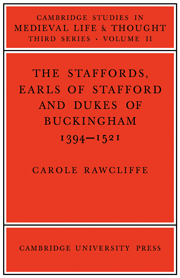Book contents
- Frontmatter
- Contents
- Dedication
- Acknowledgements
- Abbreviations
- Introduction
- 1 THE RISE OF THE STAFFORD FAMILY, 1343–1460
- 2 THE SECOND AND THIRD DUKES OF BUCKINGHAM, 1460–1521
- 3 THE MANAGEMENT OF THE STAFFORD ESTATES, 1438–1521
- 4 THE FIRST DUKE OF BUCKINGHAM'S HOUSEHOLD AND RETINUE, 1438–1460
- 5 CHANGES IN THE DUCAL LIFESTYLE, 1460–1521
- 6 THE FINANCES OF THE STAFFORDS, 14OO–1473
- 7 THE FINANCES OF THE STAFFORDS, 1473–1521
- 8 THE STAFFORDS AND THEIR COUNCIL
- 9 THE STAFFORDS AND THE COMMON LAW
- CONCLUSION
- APPENDICES
- Manuscript Sources
- Printed Sources
- Index
3 - THE MANAGEMENT OF THE STAFFORD ESTATES, 1438–1521
Published online by Cambridge University Press: 07 October 2011
- Frontmatter
- Contents
- Dedication
- Acknowledgements
- Abbreviations
- Introduction
- 1 THE RISE OF THE STAFFORD FAMILY, 1343–1460
- 2 THE SECOND AND THIRD DUKES OF BUCKINGHAM, 1460–1521
- 3 THE MANAGEMENT OF THE STAFFORD ESTATES, 1438–1521
- 4 THE FIRST DUKE OF BUCKINGHAM'S HOUSEHOLD AND RETINUE, 1438–1460
- 5 CHANGES IN THE DUCAL LIFESTYLE, 1460–1521
- 6 THE FINANCES OF THE STAFFORDS, 14OO–1473
- 7 THE FINANCES OF THE STAFFORDS, 1473–1521
- 8 THE STAFFORDS AND THEIR COUNCIL
- 9 THE STAFFORDS AND THE COMMON LAW
- CONCLUSION
- APPENDICES
- Manuscript Sources
- Printed Sources
- Index
Summary
Although the basic administrative methods common to most large estates were fairly uniform by the fifteenth century, no two families seem to have managed their property in the same way. Whereas each of the Duchy of Lancaster receiverships remained under the centralising influence of a receiver general, Richard, Duke of York's senior officials were rather more independent. Both the Staffords and the Beauchamp Earls of Warwick steered a middle course by employing a receiver general whose practical authority rarely extended beyond the areas under his personal control. These differences were influenced by geographical considerations, which, in a large and scattered inheritance, tended to reinforce the individuality of each receiving area. The Earls of Stafford were certainly pragmatic. From 1384, if not earlier, their outlying lordships of Caus, Newport, Stafford and Tonbridge had been run separately. Brecon was added in 1421 and Holderness in 1439, leaving the receiver general with a ‘central circuit’ of farms and manors in the Midlands, the Home Counties and the South West. The amalgamation of Anne Stafford's estates with those of her son in 1438 made the creation of a seventh receivership based on Thornbury in Gloucestershire an administrative necessity. The other receivers had ceased to supply their senior colleague with an annual statement of account long before this date, and the demands of Duke Humphrey's itinerant household tended to increase their autonomy. Money and supplies often worth more than £100 were handed over by the local receivers without any further authority.
- Type
- Chapter
- Information
- The Staffords, Earls of Stafford and Dukes of Buckingham1394–1521, pp. 45 - 65Publisher: Cambridge University PressPrint publication year: 1978



